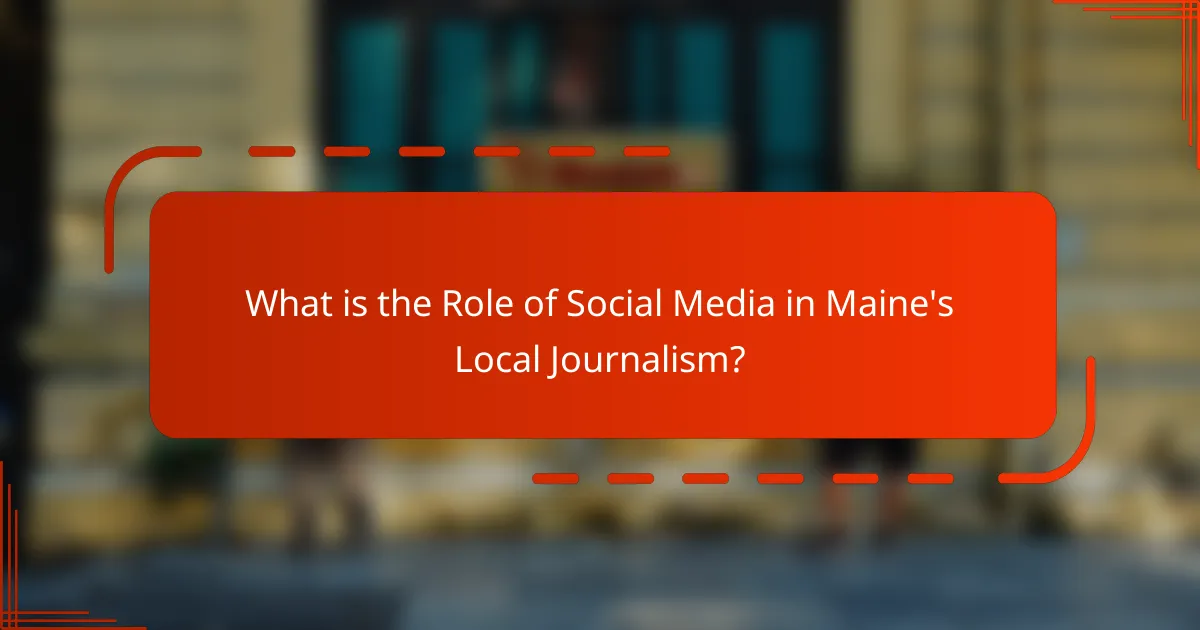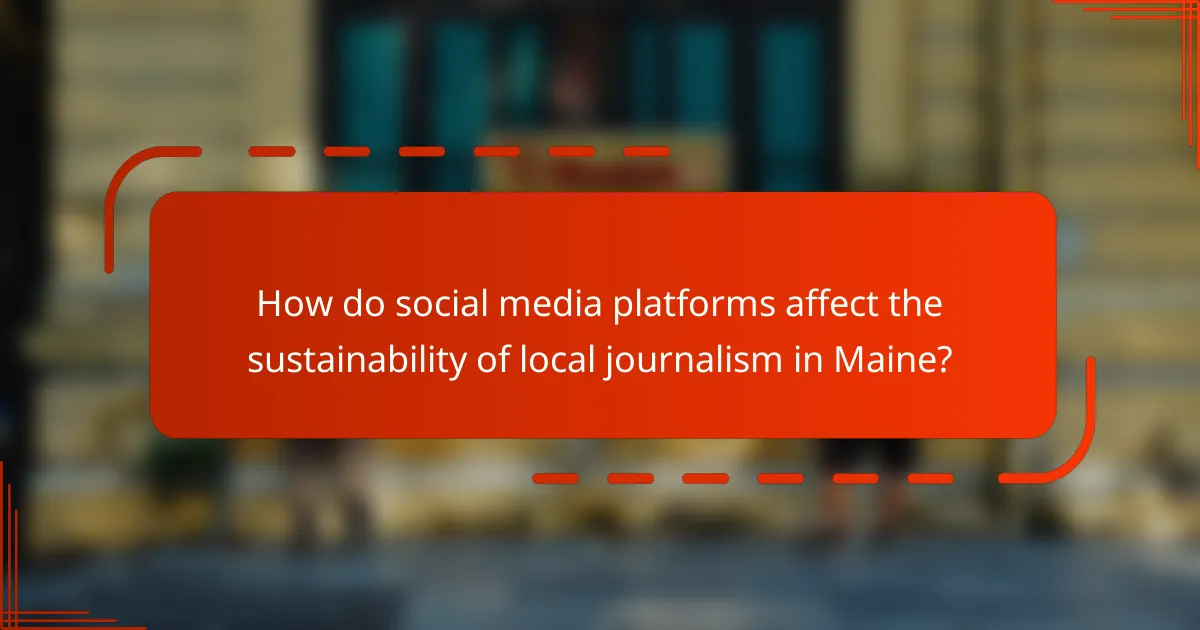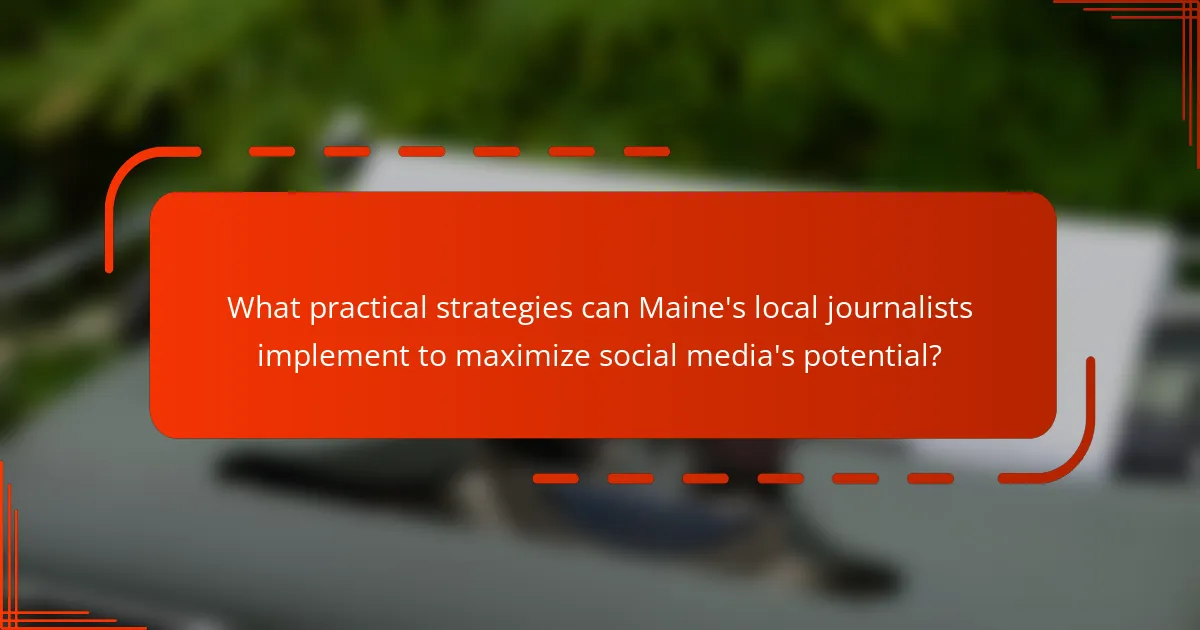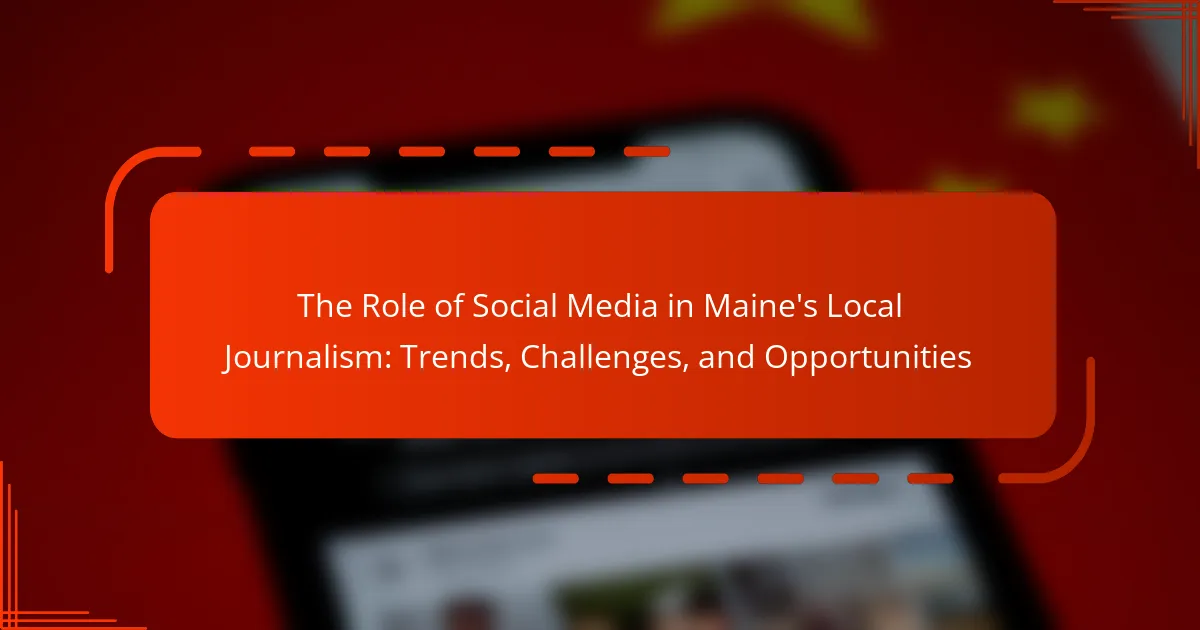Social media significantly influences local journalism in Maine by enabling real-time news sharing and direct audience engagement. Platforms such as Facebook and Twitter serve as essential tools for local journalists to disseminate breaking news and gather community feedback. While social media expands the reach of local news outlets, it also presents challenges, including decreased ad revenue and the potential spread of misinformation. Local journalists can enhance their effectiveness by actively engaging with their audience, utilizing multimedia content, and analyzing social media metrics to improve interaction and trust within the community. This article explores the trends, challenges, and opportunities presented by social media in the context of Maine’s local journalism landscape.

What is the Role of Social Media in Maine’s Local Journalism?
Social media plays a crucial role in Maine’s local journalism by facilitating real-time news dissemination. It allows local journalists to share updates quickly and engage with their audience directly. Platforms like Facebook and Twitter serve as primary sources for breaking news in the community. Additionally, social media enables local news outlets to reach wider audiences beyond traditional print and broadcast methods. According to a Pew Research Center study, 62% of Americans get news from social media, highlighting its significance. Local journalists in Maine utilize these platforms to gather feedback, source stories, and promote their work. This interaction fosters community engagement and strengthens the relationship between journalists and their audience.
How has social media transformed local journalism in Maine?
Social media has significantly transformed local journalism in Maine by enhancing accessibility and engagement. Local news outlets now utilize platforms like Facebook and Twitter to reach broader audiences. This shift allows for real-time news updates and immediate feedback from the community. According to a 2020 report by the Maine Press Association, 75% of local journalists reported increased audience interaction through social media. Furthermore, social media has enabled citizen journalism, where residents share newsworthy events instantly. This participatory approach fosters a more informed public. Additionally, social media serves as a cost-effective marketing tool for local journalism, helping to sustain operations amid declining traditional advertising revenues.
What specific changes have occurred in news dissemination?
News dissemination has shifted significantly due to the rise of digital platforms. Traditional print media has declined as online news consumption increases. Social media now serves as a primary source for breaking news. Journalists use platforms like Twitter and Facebook to share updates instantly. This shift allows for real-time engagement with audiences. User-generated content has become more prevalent, with citizens reporting news events. Algorithms influence what news is seen, often prioritizing sensational stories. Local journalism in Maine faces challenges in adapting to these changes while maintaining credibility.
How has audience engagement evolved with social media?
Audience engagement has significantly evolved with social media. Initially, engagement was limited to passive consumption of content. Users would primarily read or view posts without interaction. Over time, platforms introduced features like comments, likes, and shares. These features encouraged active participation and dialogue between users and content creators.
As of 2023, statistics show that 80% of social media users engage with brands through comments or direct messages. This shift has led to a more dynamic relationship between audiences and journalists. Local news organizations in Maine have adapted by creating interactive content. They utilize polls, live streams, and community discussions to enhance engagement.
Research indicates that 73% of consumers prefer to engage with brands through social media over traditional methods. This trend highlights the growing importance of social media as a tool for audience connection in journalism.
What are the current trends in Maine’s local journalism influenced by social media?
Maine’s local journalism is increasingly influenced by social media trends such as audience engagement and multimedia storytelling. Local news outlets are utilizing platforms like Facebook and Twitter to interact directly with the community. This interaction fosters a sense of connection and immediacy in reporting. Additionally, journalists are incorporating video and live streaming to enhance storytelling. According to a 2023 survey by the Maine Press Association, 65% of local news organizations reported increased social media use for news dissemination. This trend allows for real-time updates and broader reach to younger audiences. Furthermore, local journalism is seeing a rise in user-generated content, where community members contribute news tips and stories. This shift reflects a collaborative approach to news gathering and reporting in Maine.
Which platforms are most popular among local journalists in Maine?
Local journalists in Maine primarily use Facebook and Twitter for their reporting. These platforms facilitate real-time engagement with audiences. Facebook allows for community interaction and sharing of local news. Twitter is favored for quick updates and networking with other journalists. According to a survey by the Maine Press Association, 78% of local journalists reported using Facebook regularly. Additionally, 65% indicated that Twitter is essential for their news dissemination. These statistics highlight the dominance of these platforms in Maine’s local journalism landscape.
What types of content are being shared most frequently?
Visual content, particularly images and videos, is shared most frequently on social media. According to a 2021 report by HubSpot, posts with images receive 94% more views than those without. Additionally, video content is known to generate 1200% more shares than text and image content combined. Infographics also rank highly, as they combine visual appeal with informative data, leading to increased shares. User-generated content, such as testimonials and reviews, is increasingly popular as it fosters community engagement. News articles and local updates are shared frequently as well, reflecting the interests of local audiences. Overall, content that is visually engaging and relevant to the audience tends to be shared more often.
What challenges do Maine’s local journalists face with social media?
Maine’s local journalists face several challenges with social media. These challenges include misinformation and the rapid spread of false news. Journalists often struggle to verify facts quickly in a fast-paced online environment. The pressure to produce content rapidly can compromise journalistic standards. Additionally, local news outlets may lack the resources to effectively manage their social media presence. The competition for audience attention on social media is intense, making it difficult to engage readers. There is also the challenge of navigating changing algorithms that affect content visibility. Finally, local journalists must deal with online harassment and negative comments, which can impact their work and mental health.
How does misinformation affect local journalism in Maine?
Misinformation significantly undermines local journalism in Maine. It leads to erosion of public trust in news sources. Journalists face challenges in verifying facts amidst the rapid spread of false information. This creates a climate of skepticism towards legitimate reporting. A survey by the Pew Research Center found that 64% of Americans believe misinformation causes confusion about basic facts. Local news outlets struggle to compete with sensationalized online content. This competition can divert attention from important local issues. As a result, community engagement in journalism diminishes.
What are the implications of declining advertising revenue?
Declining advertising revenue significantly impacts local journalism. It leads to reduced budgets for newsrooms. Many local newspapers may struggle to maintain staff levels. This can result in fewer investigative stories and local coverage. As a consequence, communities may become less informed about local issues. Research shows that 1,800 newspapers have closed since 2004, exacerbating this issue. Moreover, the decline forces some outlets to rely on alternative revenue sources. This shift can affect journalistic integrity and independence. Local journalism’s decline threatens the overall health of democratic discourse.

How do social media platforms affect the sustainability of local journalism in Maine?
Social media platforms significantly impact the sustainability of local journalism in Maine. They provide new channels for news distribution, allowing local journalists to reach wider audiences. However, these platforms also contribute to revenue challenges. Many readers consume news on social media without visiting news websites, leading to decreased ad revenue for local outlets. According to a Pew Research Center study, 50% of Americans get news from social media. This trend is evident in Maine, where local news organizations struggle to monetize their content effectively. Additionally, social media can spread misinformation, undermining trust in local journalism. Thus, while social media offers opportunities for engagement, it poses significant sustainability challenges for local journalism in Maine.
What opportunities do social media present for local journalists?
Social media presents local journalists with opportunities for broader audience engagement and real-time reporting. Journalists can connect directly with their community through platforms like Facebook and Twitter. This interaction fosters a sense of trust and transparency. Additionally, social media allows for immediate feedback from audiences, enhancing story development. Journalists can share multimedia content easily, increasing the appeal of their stories. According to a study by the Pew Research Center, 73% of local news consumers use social media for news. This statistic highlights the importance of social media in reaching local audiences effectively. Furthermore, social media can serve as a tool for sourcing stories and gathering public opinion. Local journalists can monitor trends and conversations relevant to their communities.
How can local journalists leverage social media for funding?
Local journalists can leverage social media for funding by utilizing platforms to engage their audience and promote crowdfunding campaigns. They can share compelling stories that resonate with their community, encouraging financial support. Social media also allows for direct communication with followers, fostering a sense of connection. Journalists can use targeted advertisements to reach potential donors interested in local news. Additionally, they can showcase the impact of their work through updates and success stories, motivating contributions. According to a 2021 report by the Pew Research Center, 55% of local news organizations reported using social media for fundraising efforts. This demonstrates the effectiveness of social media in generating financial support for journalism.
What role does community engagement play in sustaining local journalism?
Community engagement is crucial for sustaining local journalism. It fosters trust and relevance between journalists and their audience. Engaged communities are more likely to support local news through subscriptions and donations. According to a 2020 study by the Pew Research Center, 69% of Americans believe local news is important for their community. Active participation from the community can lead to increased coverage of local issues that matter most to residents. Furthermore, social media platforms enable real-time interaction, allowing journalists to gather feedback and adapt their reporting accordingly. This dynamic relationship enhances the quality and impact of local journalism.
What are the ethical considerations for local journalists using social media?
Local journalists must navigate several ethical considerations when using social media. These include accuracy, transparency, and accountability. Journalists should verify information before sharing it to maintain credibility. They must disclose conflicts of interest to ensure transparency with their audience. Privacy concerns also arise, as journalists should respect the confidentiality of sources and individuals involved in their stories. Additionally, journalists should avoid engaging in personal disputes online, as it can undermine their professional integrity. The Society of Professional Journalists emphasizes these ethical standards, highlighting the importance of maintaining public trust.
How can journalists maintain credibility while using social media?
Journalists can maintain credibility while using social media by verifying information before sharing. They should cross-check facts from multiple reputable sources. This practice helps prevent the spread of misinformation. Additionally, journalists must disclose their sources when appropriate. Transparency fosters trust with the audience. Engaging with followers respectfully also enhances credibility. Responding to inquiries and clarifying misunderstandings shows accountability. Regularly updating their knowledge on media ethics is crucial. Continuing education helps journalists navigate the evolving landscape of social media.
What guidelines should journalists follow to ensure responsible reporting?
Journalists should follow guidelines that promote accuracy, fairness, and accountability in their reporting. They must verify information before publication to ensure its truthfulness. Citing credible sources enhances the reliability of the information shared. Journalists should avoid conflicts of interest to maintain objectivity. They must respect the privacy of individuals involved in their stories. Ethical considerations should guide their reporting decisions. Transparency about sources and methods fosters trust with the audience. Adhering to these guidelines helps uphold the integrity of journalism.

What practical strategies can Maine’s local journalists implement to maximize social media’s potential?
Maine’s local journalists can maximize social media’s potential by engaging with their audience actively. They should post regularly to maintain visibility and encourage interaction. Utilizing multimedia content, such as videos and infographics, can enhance storytelling and attract more viewers. Local journalists can also leverage trending hashtags to increase reach and relevance. Collaborating with local influencers can expand their audience and build community trust. Analyzing social media metrics helps journalists understand what content resonates with their audience. By responding promptly to comments and messages, they foster a sense of community and loyalty. Lastly, cross-promoting content across different platforms can drive traffic to their main stories and increase overall engagement.
How can local journalists effectively engage their audience on social media?
Local journalists can effectively engage their audience on social media by creating interactive content. This includes polls, Q&A sessions, and live streams. Engaging visuals such as infographics and videos can capture attention. Timely updates on local news encourage audience participation. Responding to comments and messages fosters community interaction. Utilizing local hashtags increases visibility among regional audiences. Collaborating with local influencers can expand reach. According to a Pew Research Center study, 53% of social media users prefer content that encourages interaction.
What types of posts generate the most interaction from the community?
Posts that include questions, polls, and user-generated content generate the most interaction from the community. Engaging content encourages participation and feedback. Posts that ask for opinions or experiences often receive higher responses. Polls provide a quick way for users to express their views. User-generated content fosters a sense of community ownership. Visual content, such as images and videos, also tends to attract attention. According to a study by HubSpot, posts with images receive 94% more views than text-only posts. This shows the importance of visual elements in driving engagement.
How can journalists use analytics to refine their social media strategy?
Journalists can use analytics to refine their social media strategy by monitoring engagement metrics. These metrics include likes, shares, comments, and click-through rates. Analyzing this data helps journalists understand audience preferences. They can identify which types of content resonate most with their followers. For example, posts with videos may receive higher engagement than text-only updates. Additionally, analytics can reveal the best times to post for maximum visibility. This allows journalists to schedule content for optimal reach. By continuously reviewing analytics, journalists can adapt their strategies based on real-time feedback. This data-driven approach enhances audience connection and boosts overall effectiveness in social media outreach.
What best practices should Maine’s local journalists adopt for social media use?
Maine’s local journalists should adopt several best practices for social media use. They should prioritize accuracy in reporting to maintain credibility. Engaging with the community fosters trust and encourages dialogue. Journalists must verify information before sharing to prevent misinformation. Using multimedia, such as images and videos, enhances storytelling. Consistent posting schedules help maintain audience engagement. Monitoring analytics can inform content strategies. Collaborating with other local organizations can expand reach. Lastly, adhering to ethical guidelines is essential for responsible journalism.
How can journalists balance personal and professional content on social media?
Journalists can balance personal and professional content on social media by setting clear boundaries. They should create separate accounts for personal and professional use. This allows them to control their audience and the type of content shared. Additionally, journalists can establish a content strategy that outlines what is appropriate for each account. They should regularly review their posts to ensure they align with their professional standards. Engaging with followers while maintaining professionalism is essential. According to a 2021 study by the Pew Research Center, 69% of journalists use social media for professional purposes, highlighting the importance of maintaining a professional image.
What tools can assist journalists in managing their social media presence?
Social media management tools can significantly assist journalists in managing their online presence. Tools like Hootsuite and Buffer allow journalists to schedule posts across multiple platforms. They also provide analytics to track engagement and audience growth. Sprout Social offers similar features with additional options for monitoring brand mentions. Canva is useful for creating visually appealing graphics for social media posts. These tools help streamline content creation and scheduling processes. According to a 2021 survey by the Pew Research Center, 53% of journalists use social media to promote their work. This statistic underscores the importance of effective management tools in enhancing a journalist’s reach and engagement.
The main entity of this article is social media’s role in local journalism in Maine. The article explores how social media facilitates real-time news dissemination, enhances audience engagement, and transforms local journalism practices. It discusses the challenges faced by local journalists, including misinformation and declining advertising revenue, while highlighting opportunities for community engagement and funding through social media platforms. Key trends, popular platforms, and best practices for local journalists are also examined, providing a comprehensive overview of the current landscape of local journalism in Maine influenced by social media.
